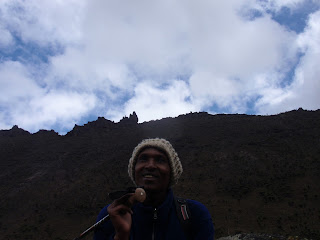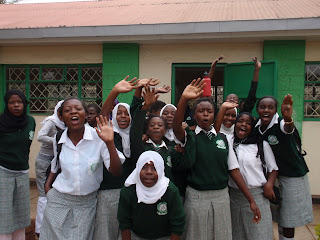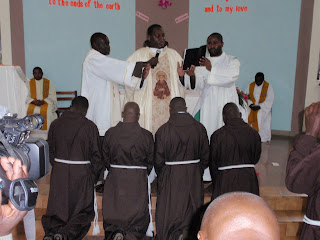Forgive me everyone for I have sinned. It has been 2 weeks and 6 days since my last blog…
This is what I have done:
1) I attended a huge AIDS awareness event for youth in a small town called Karagoya, which is on the way to Mt. Kenya. Martin, who is the friend that climbed Mt. Kenya with me, was one of the leaders in charge of the event. It was called a “Chill Day.” In the schools, the code word for AID's Awareness is “Chill,” which means to be abstinent in order to prevent the spread of AID's and other unwanted consequences of sex. Their “Chill” hand signal is the peace sign, which, as you might assume, means that they are granting “peace” to or “chilling” their desires. The “Chill Day” consisted of a bunch of clever and exciting games where the different schools in attendance competed against each other. Each game had a specific theme that was supposed to teach the students a lesson about abstinence and the benefits of self-control.
This picture shows the students shouting their team yell before they began one of the games.
When the students moved to the next game, they sprinted and shouted:
Here's me giving the top award... with the "chill" sign:
2) Then, Martin and I did the unthinkable: we climbed the 17,000 feet summit of Mt. Kenya. The climb was a thrilling three day adventure through rain, ice, snow, hail, glaciers, bog, swamp, paths turned into creeks, and indescribable sights. What makes it even better is that we were trekking through ice, snow, and glaciers on the equator! Here is the story of the trek in pictures:
Below is the park gate to the Mount Kenya National Park, so this picture marks the beginning of our ascent by foot:
This is a picture of our first day trek, which began with rain on an extremely muddy road. However, the day cleared up and turned out to be beautiful.
This is the sign outside of our lodge on the first day (note, I am covering up the 10,000 feet):
This shows us resting after the first day hike--Martin, the friend travelling with me, is the one in the middle who is covered with sweat. The guy to the left is our porter. The guy to the right... he, as you can tell, is a native Kenya:
We had a relaxing first evening by the fireside with some vegetable soup and rice (or "lice" as our guide pronounced it). We were totally not roughing it on the first day...
The second day! The path of the first half of our hike was a creek:
Here is a better picture of the path/creek:
Here is the picture of the second half...you can't tell from this photo, but this area is a bog. This means that below the tall grass, the ground is covered with 2 or 3 inches of stnading water.
Here is one of the bog plants. At night time, this plant closes up like a cabbage. If you look to the bottom left, you can see a little sliver of the standing water:
Here is another bog plant:
Closer to the end of the second day, we reached an area where we started to see rockier terrain that gradually became something like what you would see in west Texas:
Here is west Texas in the middle of Africa:
Here is another one of the outlandish plants. Below is the Teleki Valley, which leads to the final ascent of Mount Kenya:
This is a picture taken in the Teleki Valley. I decided to cool off in the near freezing water after a long second day:
A beautiful mountain creek:
Martin reflecting on the end of the second day:
The sign outside of our second lodge. The final ascent is behind the clouds off to the left:
We began our final ascent at 2:30 in the morning, so that we would be on top of the mountain by sunrise. Yes, that is a head lamp on my head:
The final push! This is our peak:
And we are there!:
This is the sight from the peak. To the very bottom right, the solid white patch is a snow covered glacier:
More of the sights from the peak:
Superman!:
We reached the peak at 7:30 AM in the morning. Then, so we wouldn't have to pay for another day of climbing fees, we rushed down the mountain. However, we hiked through falling snow, hail, and rain, which turned into creeks, then rivers, then ponds, then veritable lakes. This was our path through the bog on the way back. We were soaked from head to toe:
Finally, after hiking from 2:30 AM until 6:30 PM, that is 16 hours of hiking, we finally arrived back to the park gate:
3) A mere week and a half after my strenuous Mt. Kenya adventure, I ran my second half-marathon in the Nairobi Standard Chartered Run for Sight. I started with a great start, running the first half of the race (6.6 miles) in about 47 minutes. However, the second half was a long, miserable stretch that gradually inclined almost the entire way. The incline, however, wasn’t my difficulty… it was my shins. I have been running for some years now, and I have always had slight trouble with my shins. However, because of the vigor of the run, because my shoes are probably a little worn out, and since the race surface was a concrete road (my usual running surface in Kenya is a dirt track), my shins became completely shot. They gave out all of a sudden when I was at the beginning of an incline after about 7 or 8 miles. However, even when I ran downhill, the pain radiating from my shins made it feel like I was running up a steep incline. Despite this setback, I gritted my teeth and forced my legs forward stride by stride. The second half took a full hour, leaving me with a time of 1 hour and 47 minutes, which, I suppose, isn’t too bad for a rookie…
Here's me putting on my race number at the beginning of the race:
This is George, who is my friend that volunteered to be the photographer (and to run with me whenever he wanted to):
This is at the start of the race!:
This is a video taken during the final few minutes before my shins were shot:
Here we are at the very end, with me about to collapse...
4) Last Saturday, my students and I gathered together at our school to participate in a school beautification day, which was led by one of the national banks of Kenya. We planted trees and bushes, cleaned out classrooms, fixed a broken fence, and removed a mass amount of dirt on our sidewalks. Here are some pictures from the day:
This is a picture of me with my students at the work day:
I had to use a machete to help dig the holes for the trees:
5) All the while, teaching has been progressing well! Last week, my students had common exams in Math and English, and they did incredibly well. The tests, unlike the usual tests that my students take, were aligned to their ability level. This means that the tests weren't too easy or too hard. When the students received their tests back, many of them shouted with glee seeing that their grades went from a 20% or 30% to a 60, 70, 80, or maybe even 90 percent. I feel like all of our hard work is starting to gradually pay off…
Despite all of these things, I have no regret, no sorrow, no sense of guilt for what I have done…
Perhaps it sounds like I have been “busy.” I hate that word—it has a connotation that life has been miserable and stressful. Instead, I have been “fully engaged,” I have been “utterly alive,” I have been “thriving” –anything but miserably busy. If I have learned anything of value over the past three years of my life after college, it is this: to live life with true abundance, I need to experience the diversity of beauty that God has woven into every corner of this world; I cannot let life pass me by without reveling in its beauty, without jumping at the innumerable and novel experiences that present themselves to me each day. Hence the reason for the above stories…
However, despite all of my extraordinary experiences, I look forward to my trip back to the United States for the month of December, when I will be able to see my first baby nephew, along with my friends and family. Secondly, I look forward to devouring a juicy steak without bones and grizzle and enjoying mama’s homemade lasagna.























































